

Adding 433 to your Raspberry Pi. In this blog post I'll show you how to add RF 433MHz to your Raspberry Pi.
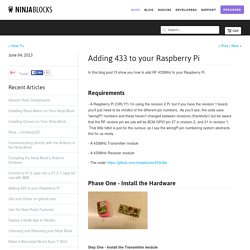
Requirements - A Raspberry Pi (ORLY?) I'm using the revision 2 Pi, but if you have the revision 1 board, you'll just need to be mindful of the different pin numbers. As you'll see, the code uses *wiringPi* numbers and these haven't changed between revisions (thankfully!) But be aware that the RF receive pin we use will be BCM GPIO pin 27 in revision 2, and 21 in revision 1. 433 MHz projects. This page is about reverse engineering protocols used in simple AM RF modules at 433 MHz.
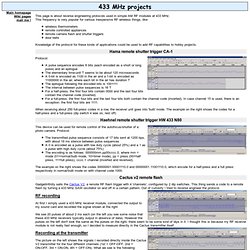
This frequency is very popular for various inexpensive RF wireless things, like: wireless thermometers remote controlled appliances remote camera flash and shutter triggers door bells Knowledge of the protocol for these kinds of applications could be used to add RF capabilities to hobby projects. Protocol: A pulse sequence encodes 8 bits (each encoded as a short or long pulse) and an epilogue The elementary time-unit T seems to be about 120 microseconds A 0-bit is encoded as 1100 in the air and a 1-bit is encoded as 11000000 in the air, where each bit in the air has duration T The epilogue following the encoded bits is 1001111 The interval between pulse sequences is 16 T For a half-press, the first four bits contain 0000 and the last four bits contain the channel code (inverted) For a full-press, the first four bits and the last four bits both contain the channel code (inverted).
Wireless Remote Control PT2272 for Arduino. There is an interesting pair of complementary Integrated Circuits, PT2262/PT2272 that make basic wireless remote control rather easy to implement.

They are commonly used in inexpensive wireless devices to control garage doors, fans, toys and even some alarm systems. These ICs utilize fixed address codes and no inherent encryption so they are not high security devices but are maybe about as secure as the average home’s inexpensive door lock. There are several iterations of these chips sold under slightly varying names with PT2262/PT2272 and SC2262/SC2272 being the most common. The PT2262/PT2272 version is manufactured by Princeton Technology Corp. of Taipei , Taiwan, while the SC2262/SC2272 is manufactured by SilvanChip Electronics Tech.Co.
HomeEasyProtocol. More 433Mhz RF Hacking. I touched on the smoke detectors and door/window sensors I ordered last week: – here are a few more details.

The smoke detectors were £5.75 each – (all now sold out, but more available on a separate listing from the same seller – The door/window sensors were £2.50 each – (shop link if/when the listing ends – The RF signals broadcast by both devices are not decoded by the RFXCom receiver/transceiver RFXtrx433. This meant finding a way to receive and decode myself. Using a cheap OOK radio with the TinyTX « nathan. By Nathan Chantrell, on June 21st, 2013 TinyTX with OOK radio Going the opposite way to the last post this is a version of the TinyTX wireless sensor node using a very cheap radio setup.

I first experimented with this 433MHz OOK/ASK radio pair a few years ago with an ATmega328 and the VirtualWire library but I never did much with it beyond a simple demo and when I started using the RFM12B it got shoved in a drawer and forgotten about. At some point I dug it out and botched it onto the TinyTX V2 board you see here but it seems that the internal oscillator on the ATtiny84 isn’t accurate enough for the timing required for VirtualWire and I couldn’t get it to work so it languished in a drawer for a while longer. Google Calendar, Raspberry Pi and Lights On / Lights Off. Summary Combining these ingredients:an Elro "Wireless Home Control" seta Raspberry Pi mini-computersome solderingsome programming andGoogle Calendar ...
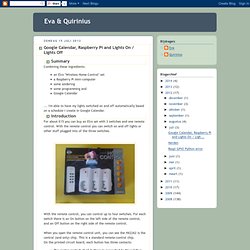
I'm able to have my lights switched on and off automatically based on a schedule I create in Google Calendar. Introduction. RaspberryPi - ATtiny85, I2C, 433MHz. PiHAT - Rasberry Pi Home Automation Transmitter. Remote controlled power outlets 433Mhz. Using a Raspberry Pi for home monitoring and automation. Decoding 433MHz RF data from wireless switches. [Update 2013-03-01] I have added more documentation on the codes these remotes use in a different post.
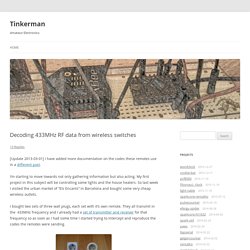
I’m starting to move towards not only gathering information but also acting. My first project in this subject will be controlling some lights and the house heaters. So last week I visited the urban market of “Els Encants” in Barcelona and bought some very cheap wireless outlets. I bought two sets of three wall plugs, each set with it’s own remote. They all transmit in the 433MHz frequency and I already had a set of transmitter and receiver for that frequency so as soon as I had some time I started trying to intercept and reproduce the codes the remotes were sending. Sample outlets from each set plus remotes In the image above you can see an outlet and the remote for each of the sets. The right one is branded “Avidsen” and rated 1000W, just below the consumption of my house electrical heaters, but good to control lights and other appliances. Rogier's Tinker Projects: Control lights with an Arduino remotely with 433Mhz.
I wanted to use Arduino's for a domotica project.

The main purpose is to control the lights in my livingroom, using a web-interface. Sniffing the Air (RF controlled lights) Interface with Remote Power Sockets – Final Version « Rayshobby. In previous blog posts, I’ve described two ways to use an Arduino to interface with an off-the-shelf remote power sockets / switches.

The first method uses transistors to simulate button presses. It involves some soldering and hacking the remote control unit. The second method uses an oscilloscope to sniff the signal sent by the remote control, and then simulates the same signal using an RF transmitter. But what if you don’t have an oscilloscope, or don’t know where to place the probe to take the measurement?
RF433. Analyzer:manual:start - Nethome. Connecter des dispositifs sans fil à votre Arduino ou Raspberry Pi, Partie 1: Réception en 433Mhz / HackSpark, l'électronique facile ! Cette entrée a été publiée le 20 décembre 2012 par Jonathan de HackSpark.
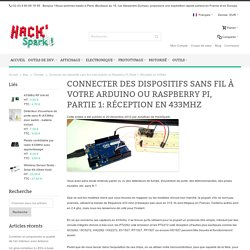
Vous avez sans doute entendu parler ou vu des détecteurs de fumée, d'ouverture de porte, des télécommandes, des prises murales, etc. sans fil ? Que ce soit les modèles chers que vous trouvez en magasin ou les modèles chinois bon marché, la plupart, s'ils ne sont pas avancés, utilisent la bande de fréquence 433 mhz (n'essayez pas ceux en 315, ils sont illégaux en France). Certains autres sont en 2.4 ghz, mais nous les laisserons de coté pour l'instant. En ce qui concerne ces capteurs en 433mhz, il se trouve qu'ils utilisent pour la plupart un protocole très simple, introduit par des circuits intégrés chinois à bas cout, les PT2262 coté émission et les PT2272 coté réception (d'autres plus exotiques comme les SC5262 / SC5272, HX2262 / HX2272, EV1527, RT1527, FP1527 ou encore HS1527 peuvent être trouvés et fonctionneront aussi).
Safe Automated Mains Sockets. What's this all about? This page describes how to turn mains powered appliances on and off under computer control without risking killing yourself. That last part is kind of important. Links for source code downloads Switch.cppWeb Interface More Detail. Control RF Mains Plugs using the RFM12Pi.